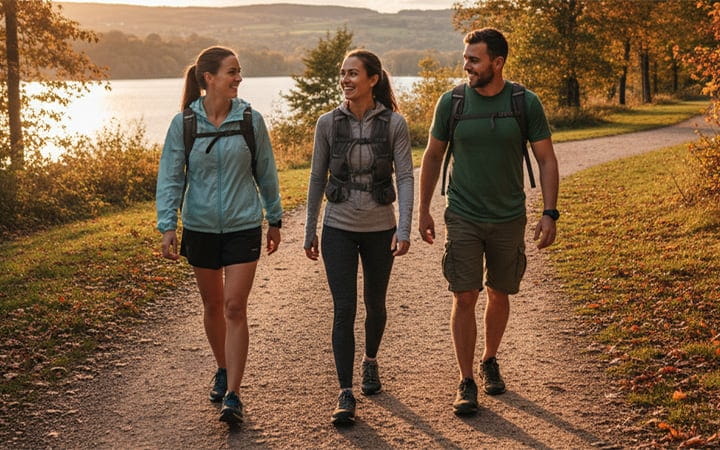Weighted Vests: A Trend to Try?
September 24, 2025

Weighted vests seem to be everywhere lately – from neighborhood walking groups to online fitness challenges. If you’re wondering where they came from, you’re not alone.
The truth is, while they may seem like a new trend, weighted vests have been used for years in endurance training and physical therapy. What’s changed is how they’re designed, who’s using them and why people are adding them to their fitness routines.
“Just like any type of training, these vests can help strengthen your bones and build muscle,” explains Jacob Calcei, MD, a sports medicine specialist at University Hospitals Drusinsky Sports Medicine Institute. “The key is to use them safely.”
That means easing into a weight and frequency that works for you. Here’s how.
From Training Gear to Wellness Craze
For years, weighted vests were a niche tool used in sports performance, rehabilitation and training for people whose jobs demanded extra strength. Athletes used them to add resistance to drills. Physical therapists sometimes turned to lighter versions to help patients rebuild bone and muscle after injury. Soldiers, police officers and firefighters trained in heavy gear to prepare for the physical challenges of their work.
The wider fitness world started to take notice when manufacturers began making vests that were lighter, more adjustable and comfortable enough for everyday activities. Social media gave the trend a boost, with walkers, runners and even office workers showing how a few extra pounds could make regular movement more challenging – and rewarding.
Add in growing awareness of bone health, especially among post-menopausal women concerned about osteoporosis, and weighted vests became one of the most talked-about fitness accessories of the moment.
How Weighted Vests Help
A weighted vest adds load to your body, forcing muscles, bones and your cardiovascular system to work harder during movement. “It’s great addition to activities like walking, hiking hills or climbing stairs,” notes Dr. Calcei.
The extra weight increases resistance without requiring a complete overhaul of your workout. “Even a small amount – one or two pounds – can stimulate muscle growth, help maintain bone density, and give your heart and lungs more of a workout,” Dr. Calcei says.
For many, the biggest draw is bone health. Load-bearing exercise stimulates bone cells to grow stronger, making a vest a useful addition for people looking to prevent or slow bone loss with aging. Others use them to build strength with everyday activity, without the need for heavy gym equipment.
There’s also a functional benefit: Moving under a bit of extra load can improve balance, stability and everyday strength. Over time, carrying groceries, lifting luggage or doing housework can feel easier. And because a vest can be worn during low-impact exercise, it’s an appealing option for those who want to avoid high-impact moves but still challenge their bodies.
Getting Started – Safely
As with any fitness tool, gradual progression is key. Dr. Calcei recommends starting light and seeing how your body responds before adding more weight.
“Start with a low weight then increase gradually over time,” he says, with a low-weight vest or even t-shirts or undergarments sold with a bit of built-in weight. “They can give you that feeling of resistance without altering your mobility,” adds Dr. Calcei.
Look for a design that fits close to the body without restricting movement. Adjustable weights let you start light and increase resistance in small increments. Breathable materials help keep you comfortable during longer wear, and evenly distributed weight – front and back – can help avoid straining your back.
As for how often to suit up, every day is not recommended. “Two or three sessions per week is enough, with rest days to give muscles and joints time to recover,” notes Dr. Calcei.
While in motion, pay attention to posture: Keep your shoulders back, core engaged and movements controlled. If you notice joint discomfort or fatigue, reduce your vest’s weight or frequency of use.
Who Should Hold Off
Weighted vests aren’t recommended for everyone. They add stress to the joints and spine, which can cause irritation or inflammation if overused. People with low back pain, joint instability or significant muscle tightness should address those issues before adding extra weight to their routines. The same advice applies if you’re pregnant or have been told by your healthcare provider to avoid weight-bearing exercise.
“In those cases,” says Dr. Calcei, “work on flexibility and dynamic movement first, before using a weighted vest. You don’t want to increase your risk for injury.”
A Trend Worth Taking up
On the whole, Dr. Calcei and other experts believe weighted vests can be a safe way to make the workouts you already enjoy work harder for you.
By starting light, using them just a few times a week and focusing on low-impact, controlled movements, you can strengthen bones, build long-term muscle stability and improve cardiovascular health – all without dramatically changing your routine.
Related Links
Sports medicine specialists at University Hospitals offer comprehensive orthopedic care for athletes of all ages and abilities, including performance training, on-site surgical services, and physical and occupational therapy.


